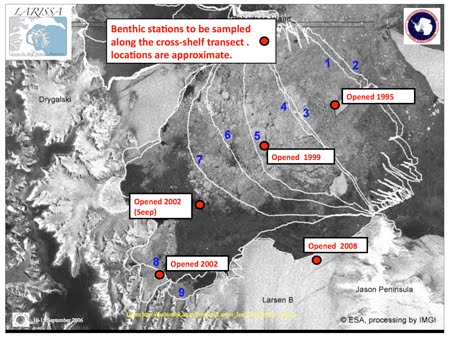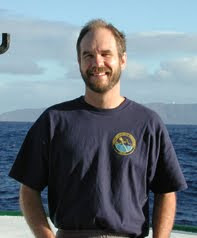
The NB Palmer dwarfed by a tidewater glacier calving into Flandres Bay, a fjord on the Danco Coast.

Map of the Antarctica Peninsula, showing the fjords of the Danco and Graham Coasts.
The Fjords of the west Antarctica Peninsula are oceanographically extremely interesting because they contain “tidewater glaciers”, i.e., glaciers calving icebergs directly into the ocean. In addition, the Antarctic Peninsula fjords have only opened relatively recently (in the last few thousand years), i.e., they represent early stages in the transition of fjords from ice-choked polar to ice-free temperate ecosystems. The oceanography and seafloor ecology of of fjords have been intensively studied in Norway, Canada and Alaska, but these are warm fjords compared to the Antarctic Peninsula and contain rapidly melting glaciers or no glaciers at all. The marine ecosystems of the Antarctic Peninsula fjords are likely to be fundamentally different (e.g., they have relatively little input of glacial meltwater and rock flour) and yet they have been little studied. Thus, while waiting to complete our helicopter operations, the oceanographers on board the NB Palmer are conducted studies of the ecology of the Peninsula Fjords.

Massive front of tidewater glaciers emptying into Barilari Bay.


Humpback whales feeding in Flandres Bay, some only meters from the bow of the ship!

Abundant brittle stars, sea spiders, spoon worms, and starfish on 2 square meters of seafloor at a depth of 600 m in Flandres Bay fjord.
After studying two fjords near Anvers Island, we are now heading south to Barilari Bay, a fjord south of Cape Garcia on the Graham Coast. If the weather clears, we hope to send glaciologists on to the top of the Peninsula to emplace GPS units to measure glacial movement. However, since the weather has remained cloudy, preventing helo operations since we arrive on the west side of the Peninsula more than one week ago, we are quite worried that we can complete the helicopter transfers. At least we can explore the ecosystem of another fjord, working with truly breathtaking backdrops.

Conducting a plankton tow from a zodaic inflatable boat with a Flanders Bay glacier and mountains as backdrop.





Uau!, really cool pic guys. The animals on the bottom look a lot different from the other sites in WAP. Good job! Angelo.
ReplyDelete